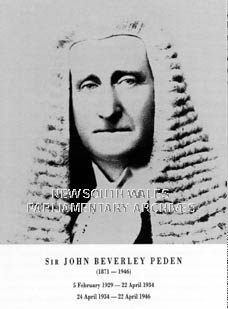
Date of Birth: 25/04/1871
Place of Birth: Randwick, New South Wales, Australia
Date of Death: 31/05/1946
Place of Death: Paddington, New South Wales, Australia
Parliamentary Service
| President of the Legislative Council |
24 Apr 1934 |
22 Apr 1946 |
11 years 11 months 30 days |
The first President to be elected by the Members of the Legislative Council |
| Member of the NSW Legislative Council |
23 Apr 1934 |
22 Apr 1946 |
12 years |
A Member of the indirectly elected Council 1934 - 1978. A Member before reconstitution. |
| President of the Legislative Council |
05 Feb 1929 |
22 Apr 1934 |
5 years 2 months 18 days |
Last President appointed by the Governor |
| Member of the NSW Legislative Council |
17 Jul 1917 |
22 Apr 1934 |
16 years 9 months 6 days |
Life Appointment under the Constitution Act. Date of Writ of Summons 6 May 1917 |
Political Party Activity
National Party, councillor 1917-1918.
Qualifications, occupations and interests
Lawyer (barrister) and Professor. Educated at Bega Public School, Sydney Grammar and University of Sydney, BA 1892, LL B 1898; assistant of lecturer in Latin University of Sydney 1896; called to Bar 1898 registered on North circuit; law lecturer University of Sydney 1903, professor, Dean of Law Faculty, fellow of Senate University of Sydney 1910-1941; vice-warden St John's College 1892-1899, fellow 1898-1928; Judge Advocate 1916; trustee Member of Legislative Council Assurance Co. Ltd; director of New South Wales Land and Agency Co. and associated companies; owned farm at Cobargo near Bega; Chairman trustees Sydney Grammar School 1932-1946; executive of Universal Service League 1915-1916; Chairman Sydney Round Table group; trustee of Captain Cook's Landing Place at Kurnell; president of Sydney University Union 1893-1894, 1910-1911; joint secretary of Australasian Association for Advancement of Science 1898; member Australia Club; chancellor of diocese of Bathurst and later of Newcastle.
Honours Received
Kings Counsel in 1923. Knight Commander of the Order of St Michael and St George in 1930.
Membership of other Parliaments & Offices Held
Local Government Activity
Personal
Son of Magnus Jackson, farmer and Mayor of Randwick, and Elizabeth Neathway Brown. Married Margaret Ethel Maynard on 21 December 1904 and had issue, 2 daughters. Church of England. North Suburbs Crematorium from St Andrew's Church of England Cathedral.
Additional Information
Personal papers in the Mitchell Library, State Library of New South Wales: 1.
Peden family - papers, 1833 - 1947 (MLMSS 1663); photographs in the PICMAN
Database. 2. Peden family - further papers, 1876 - 1946 (MLMSS 3765).
Australian Dictionary of Biography, Volume 11
Ken Turner and Michael Hogan (editors), The Worldly Art of Politics, Sydney,
Federation Press, 2006 (Chapter 14: "Sir John Peden: Representing the public
interest", by Gareth Griffith, page 155)
Text from the book: 'The Presiding Officers of the Parliament of New South
Wales', Sydney, 1995
John Peden was born on 25 April 1871 at Randwick in Sydney. He married Margaret
Maynard in December 1904 and they had two daughters. Peden's father, Magnus
Peden, was Mayor of both Randwick and Bega. Academically brilliant, John
Peden's accomplishments included First Class Honours in both Latin and Law, as
well as the University Medal for Law. Although he established a successful
practice, Peden directed his legal expertise towards lecturing and organising
the Law Department as the Dean of the Sydney University Law Faculty. Most
notably, Peden was an authority on Australian and New South Wales
constitutional law.Peden was a Member of the Legislative Council from 1917
until his retirement in 1946. As President of the Council between 1929 and
1946, Peden brought to the office his skill as an orator and an immense legal
knowledge. A passionate supporter of preserving the traditions of the Council,
Peden was of the view that as a house of review, the Council could maintain
objectivity because Bills before the Chamber would be considered solely on
merit rather than from a political allegiance. Peden's belief in the continued
existence of the Legislative Council was tested by J T Lang's efforts to
abolish the Council. In 1929 he ensured the Council's continued existence by
drafting and inserting section 7A into the Constitution Act of 1902 by an
amendment. The amendment guaranteed that the Council would neither be abolished
nor have its powers altered except through a referendum. Furthermore, Peden
established a safeguard by preventing amendments or a repeal of Section 7A
without a referendum. Peden was the last President to be appointed; and the
first to be elected by the House after the reforms of 1934. Possessing a sound
knowledge of both Standing Orders and Parliamentary procedure he was able to
command control of the House with great ease. Sir John Peden died at Paddington
on 31 May 1946, one month after retiring.
